Would you like to travel around Ireland with a motorhome? Then you’ve come to the right place. One of the best ways to experience the island to its fullest is to travel with a motorhome. Flexible, independent, and close to nature – this is the perfect way to explore the Emerald Isle on your own.
But which caravan/camper is best? What costs will you incur, and what should you consider when planning? In this article, you’ll find practical travel tips, information on pitches, and a cost overview to help you perfectly prepare for your trip through Ireland. Enjoy browsing!
- Suitable motorhome for Ireland
- Ireland with a motorhome – Our model
- Popular round trip routes through Ireland
- Driving in Ireland
- Toll roads
- Campsites in Ireland
- Freestanding & Parking
- Wild camping in Ireland
- Fueling
- Fresh water, grey water, garbage & toilet
- Shopping along the way
- Costs of our round trip through Ireland
- Packing list for motorhome travel
- Ireland with a motorhome – Our conclusion
Suitable motorhome for Ireland
The right motorhome for a Ireland round trip depends on various factors, including the size of the vehicle, road conditions, and comfort. Since Ireland’s roads are often narrow and winding, especially in rural areas, the motorhome should offer a good balance between maneuverability and comfort.
Compact motorhomes: For Ireland’s narrow and winding roads, compact motorhomes are often the best choice. These offer enough space for 2 to 4 people, but are small enough to safely navigate narrow country roads and are easier to park in cities. Models like the VW California or similar campervans are ideal if you’re looking for flexibility and mobility. roadsurfer* has many great models on offer.
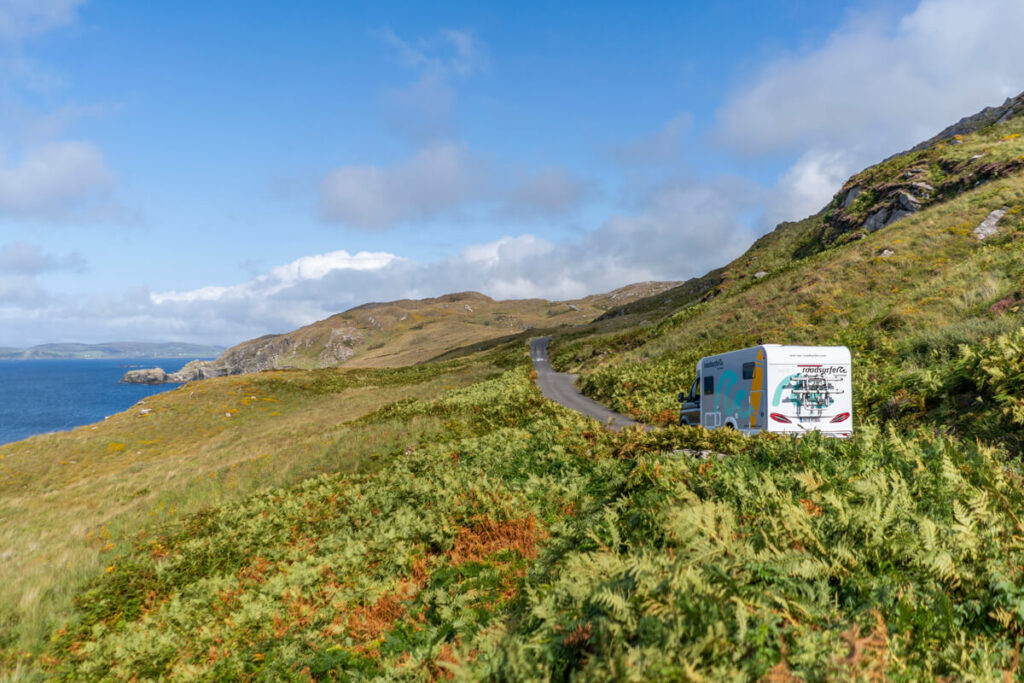
Mid-sized campervans: If you want to travel in more comfort but still want to remain flexible, mid-sized campervans are suitable. They can accommodate 4 to 6 people but are still relatively easy to drive on Ireland’s roads. A model like the Fiat Ducato or the Ford Transit Custom with a campervan conversion can be a good choice here.
Large Motorhomes: Larger motorhomes with plenty of living space (e.g., alcove motorhomes) offer a high level of comfort, but are often more difficult to maneuver on Ireland’s narrow roads. If you need a lot of space, plan your route carefully to choose passable roads. Large motorhomes are better suited to wider roads and well-maintained routes such as the Wild Atlantic Way or national roads.
Ireland by Motorhome – Our Model
There are numerous motorhome rental companies in Ireland, offering a wide selection of vehicles to suit different needs. Most motorhome rental companies have pick-up locations in the major cities and airports, including Dublin, Cork, and Belfast. It’s worth checking in advance whether a one-way rental is possible if you want to return the motorhome at a different location.
Provider: roadsurfer
We rented our motorhome from roadsurfer*. We knew this provider through social media, as we occasionally saw travelers there who had rented a camper or motorhome.
This provider was actually the cheapest when we were spontaneously looking for a suitable “home on four wheels.” We booked the motorhome just two weeks before the start of our trip.
Important information about the motorhome
- Pick-up: Station just 10 minutes from Dublin Airport
- 177 HP diesel
- 2 front seats (swivel) + 2-seater bench seat behind
- Size: Length 6.99 m, width 2.43 m, and height 3.01 m
- Automatic transmission, cruise control, and rear view camera
- Integrated navigation system
- Bluetooth, USB, radio, Apple CarPlay, and Android

Features of our motorhome
Since we were super spontaneous, only the “Cozy Cottage” model was available. In retrospect, however, it was a real stroke of luck. We enjoyed the on-board comfort to the fullest. Furthermore, this vehicle didn’t have that many kilometers on the clock and didn’t seem “worn out” at all.
Sleeping Area
The sleeping area in the rear is very spacious and comfortable. There’s also an incredible amount of storage space on board for luggage, clothing, food, and other items. The sleeping area (almost 2×2 meters) is accessed via a small ladder, which might be a disadvantage for people with disabilities.
Around the bed, you’ll find five compartments for storing clothes. There’s also a window on the left, a window on the right, and one on the ceiling that opens up. The sleeping area also features warm, indirect lighting and a reading lamp on the left and right.
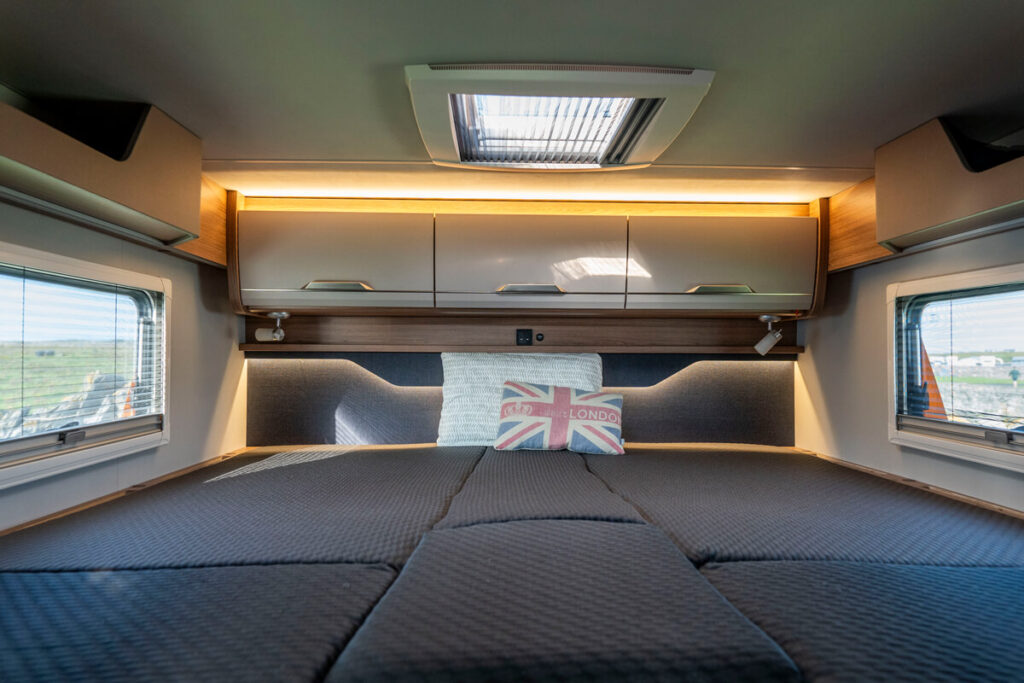
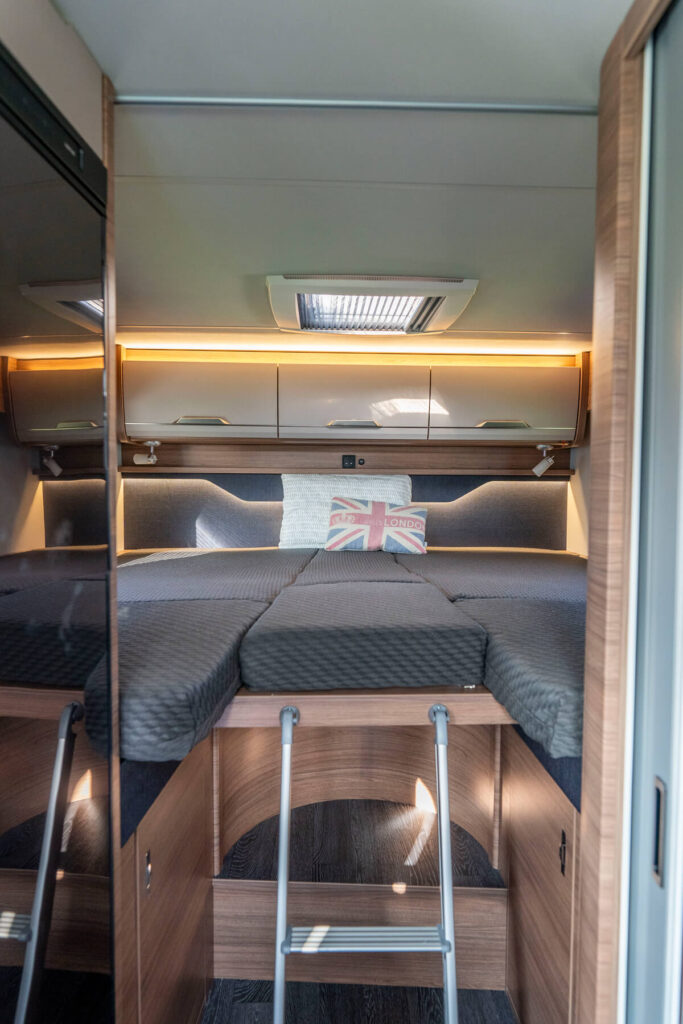
Bathroom
The bathroom features a closet, a shelf, a large mirror, a sink, a hot water shower, and a toilet. We only had to empty the latter twice in 10 days (just for peeing). There are enough hooks distributed throughout the caravan for hanging up clothes or towels.
We only showered in the caravan once to test it out. Conclusion: Works wonderfully. You have to turn on the boiler beforehand so the water can heat up. This took us about 20 minutes. We generally found it very advantageous to have a toilet on board.
Note: We always did our “big business” in restaurants, cafés, public restrooms, shopping centers, etc. It was never a problem. If there had been an emergency, we would have used the toilet in the caravan for that purpose. But it was never necessary.
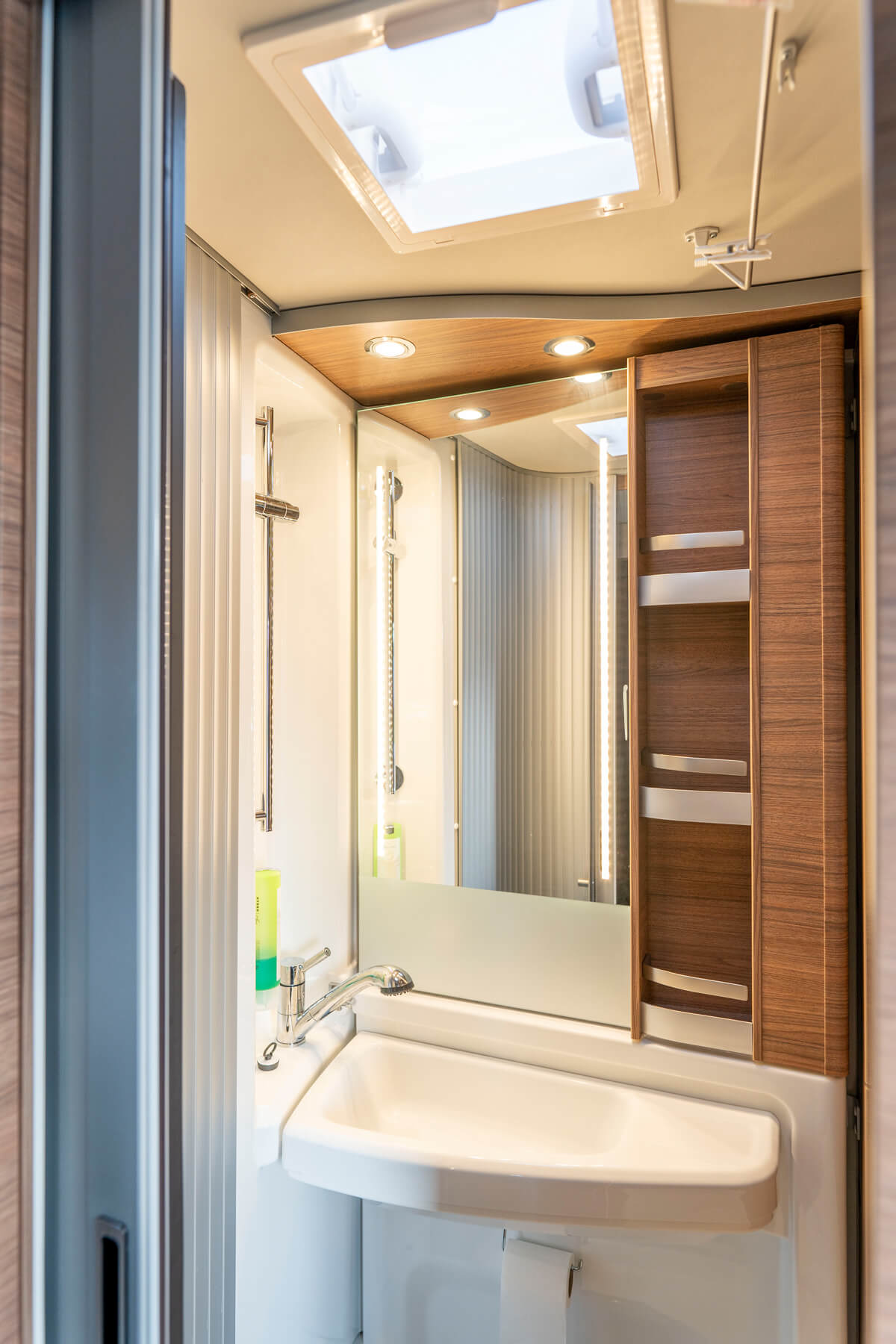
Kitchen
The kitchen is equipped with a two-burner gas stove, a sink, and a very large 142-liter refrigerator including a freezer compartment. Three large drawers and two compartments provide ample storage space. The kitchen box contains the necessary dishes for four people.
Included are, among other things, large and small plates, three pots of different sizes, a frying pan, smaller bowls, a knife, fork, spoon, as well as cups, mugs, an espresso maker (Frech Press), a can opener, a vegetable peeler, and a cutting board. Only the “pan” is an absolute disaster.
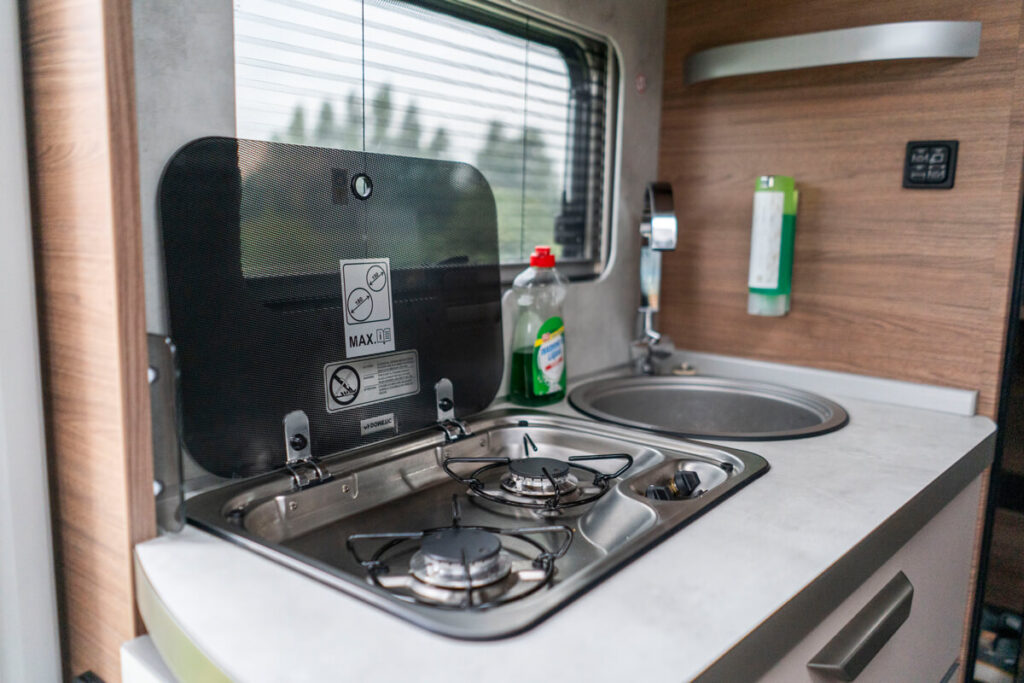
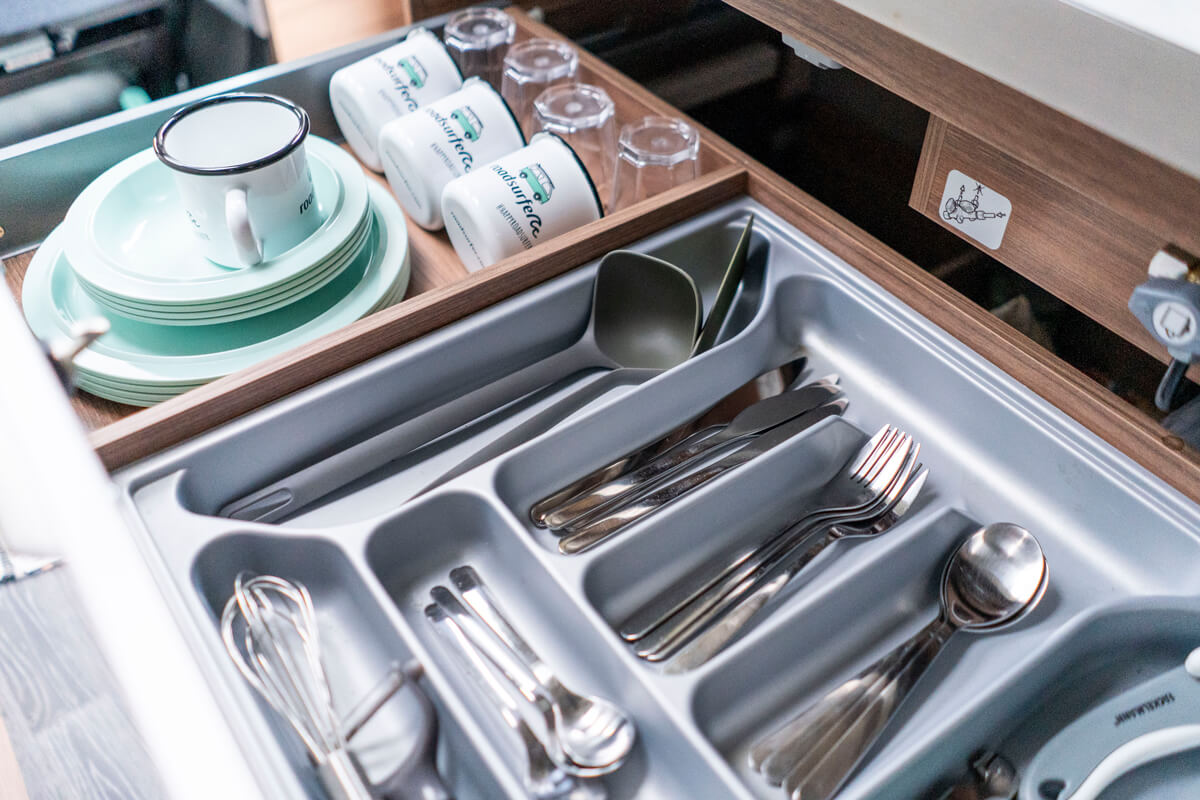
Living Area
The driver and passenger seats can be turned around in no time. The table is large enough and can even be extended. The 2-seater bench seat provides enough space around the table. Above the table are two lockable compartments and a USB port for charging your cell phone, etc. There is a socket at the bottom of the bench seat, which can be used when the motorhome is connected to the power supply.

Other amenities
We also didn’t have to freeze in this motorhome. The air heater is powered by gas, allowing you to be self-sufficient for up to two days. When the engine is off, you can also use the parking air conditioner. All windows and panes are equipped with fly screens and blackout blinds. The water tank has a capacity of 100 liters.
Other accessories
Camping table and two chairs, wheel chocks, Awning, window shade, external power cable with adapter, hand broom, water canister, and two gas bottles. You can also book additional accessories for a fee, such as a bike rack, roof rack, bed linen, child seat, etc. We stowed our suitcases in the huge “trunk.”
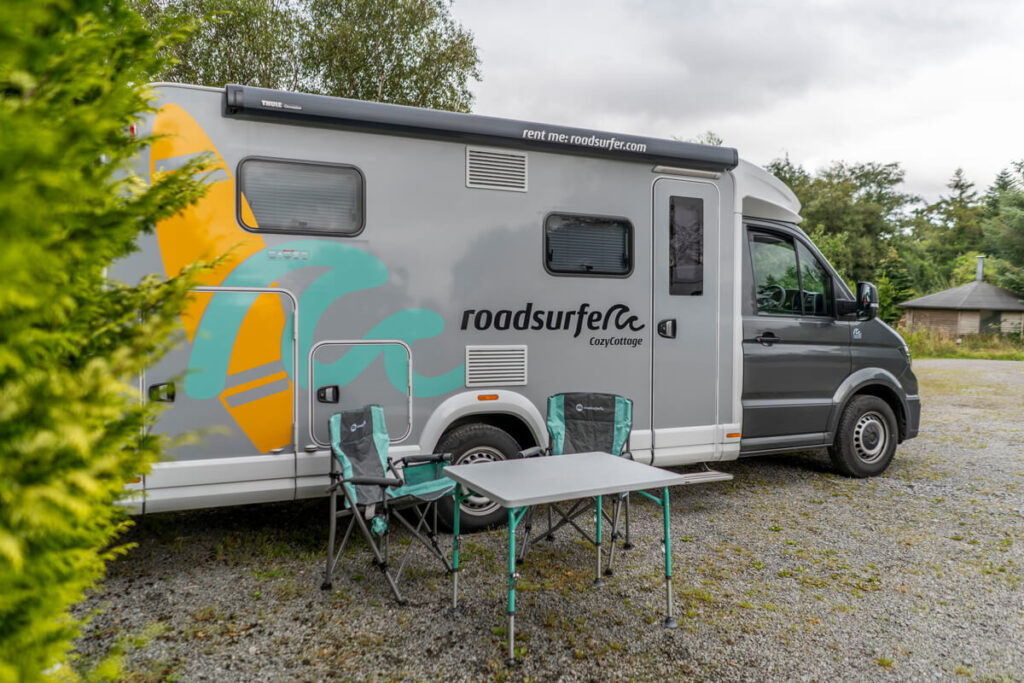
Our Review
The bed linen costs €35 per person and has to be booked separately, which we find quite expensive. When we booked our caravan, this “extra” was already sold out, so we had to bring our sleeping bags and pillows from home. However, two sheets were already provided in the camper. It would certainly have been more comfortable with a proper blanket.
You can get an introduction to the motorhome online in advance via the roadsurfer* website using a guide and video. This is probably intended to save time during pickup. We actually thought this was pretty cool, as it allowed us to familiarize ourselves with the motorhome from home.
However, there are certainly people who are simply not so familiar with this medium and perhaps have never traveled in a motorhome of this type before. However, you can still ask questions and get help when you pick it up.
Popular Round Trip Routes through Ireland
Ireland offers a variety of scenic routes. Some of the most beautiful routes that are ideal for a motorhome trip are:
Wild Atlantic Way: One of the longest coastal roads in the world, stretching over 2,500 km from Donegal in the north to Cork in the south. It leads through rugged coastal landscapes, charming villages, and breathtaking views. You can drive the entire route (3 to 4 weeks) or just part of it (1 to 2 weeks).
Causeway Coastal Route (Northern Ireland): This route follows the dramatic north coast, with highlights such as the Giant’s Causeway and the Carrick-a-Rede Rope Bridge. You should allow at least 1 to 2 weeks for this route.
Ring of Kerry: This route features spectacular mountain scenery, lakes, and coastal roads. It’s particularly popular for day trips and short tours. You should allow at least 2 to 3 days. Alternatives: Ring of Beara (1 day) and Dingle Peninsula (1 to 2 days)
Our route through Ireland
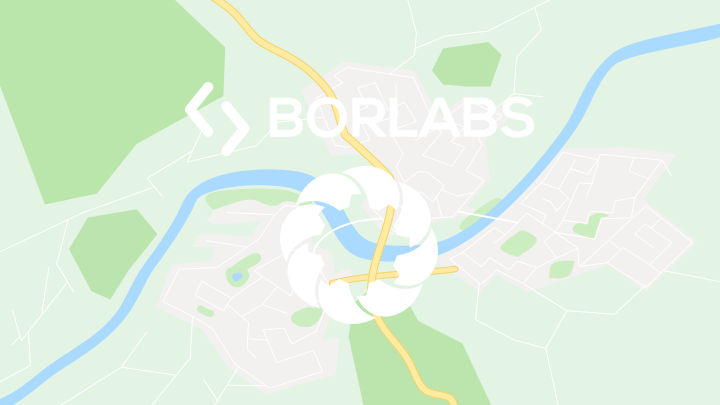
By loading the map, you accept Google’s privacy policy.
Learn more
Load map
Driving in Ireland
In Ireland, traffic drives on the left, which may be unusual for many at first. Take your time to get used to driving on the “wrong” side, especially on narrow, winding country roads. Watch out for vehicles coming from the right at roundabouts and always drive clockwise. The Irish generally drive very relaxed and are considerate.
On winding roads in rural areas, you should keep a sufficient distance from the left edge of the road. Many single-lane roads have layouts where you can stop to let oncoming traffic pass. However, there are also roads in Ireland that large motorhomes cannot use at all. Pay attention to the signs here.
Important information:
- Ring of Dingle: always drive clockwise.
- Ring of Kerry: trucks and buses drive anticlockwise.
- Ring of Beara: best to drive clockwise.
- Connor Pass: closed to vehicles over 2 tons. not passable for motorhomes and caravans
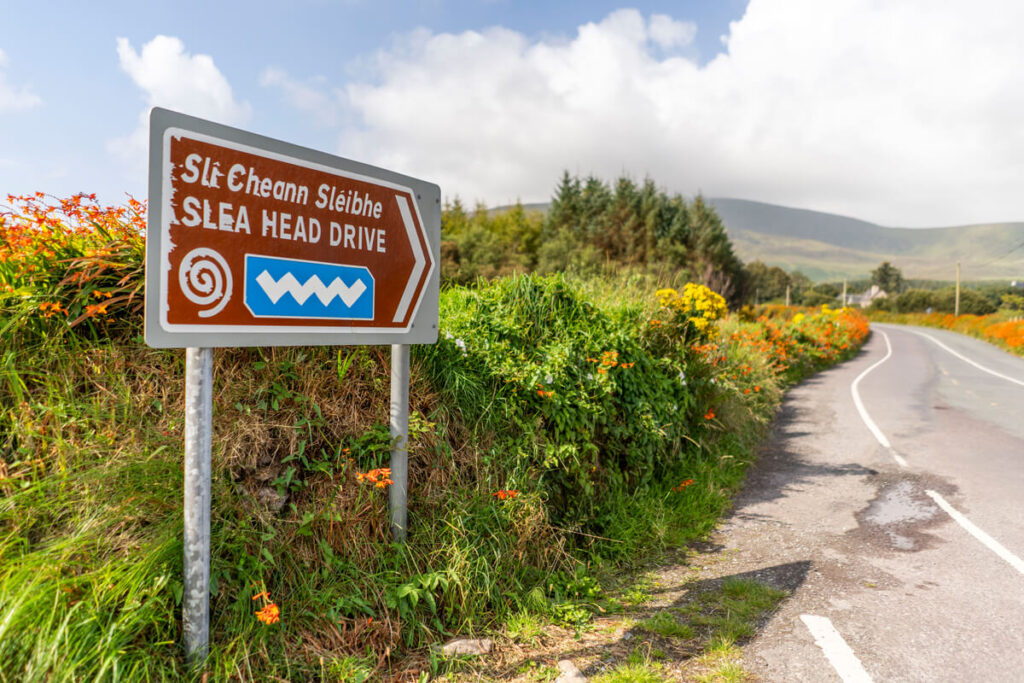
Speed limits in Ireland
- 50 km/h: In built-up areas
- 80 km/h: On country roads
- 100 km/h: On national roads (comparable to federal highways)
- 120 km/h: On motorways
Parking
Parking with a large motorhome can be difficult in cities and small villages. Plan parking options in advance and use dedicated motorhome parking areas or park-and-ride parking spaces. We usually checked Google Maps and the Park4Night app beforehand to find the best parking spots.
In most cases, we didn’t have to pay anything, unless we were parked in a parking lot right in the city. such as in Killarney or Cobh. Parking usually cost us €1 to €2 per hour. Occasionally, we were also asked for a parking disc (“parc disc”). Important: Yellow stripes on the side of the road generally prohibit parking!
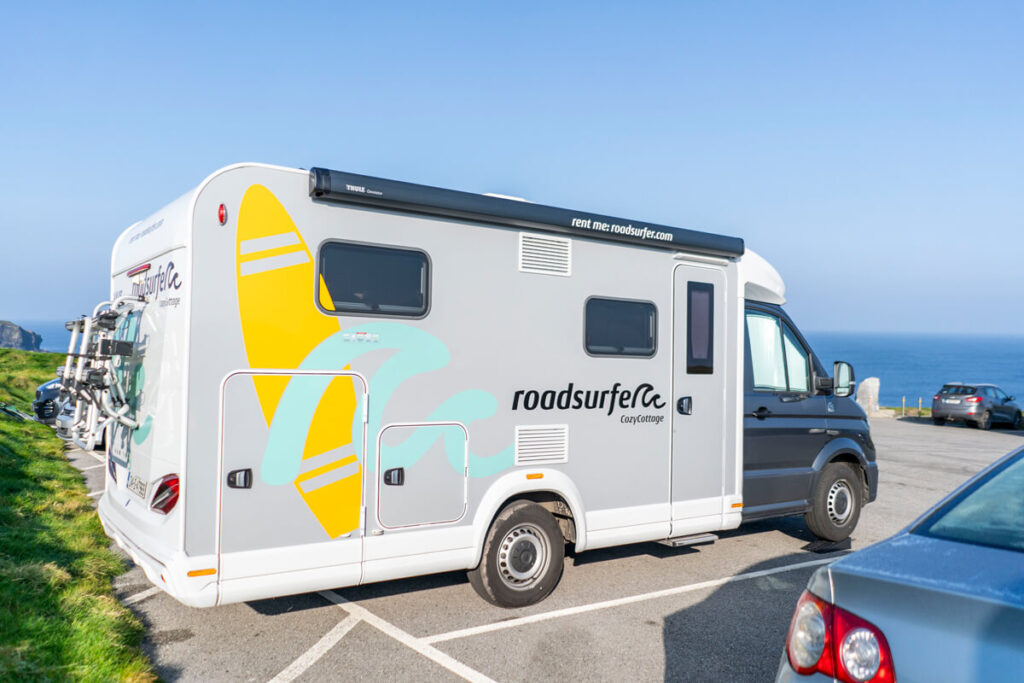
You’ll also occasionally come across parking spaces with a height restriction (usually 2 meters). Then, of course, you’re out of luck with your motorhome and have to look for another spot. However, we never had any problems finding an alternative nearby. If it’s busier, it can take more time to find another parking space.

Toll roads
Some sections of the motorways in Ireland are subject to tolls. Find out about the applicable fees and how to pay beforehand. We were able to pay everywhere with a credit card. In most cases, we only had to pay €2.30, as motorhomes are tolled like cars. To the toll sections.
Only on the M50 around Dublin is there an electronic toll, which must be paid online or in certain shops before or after the journey (www.eflow.ie). There are no toll stations on the M50, and if you forget to pay, you could face a fine.
Campsites in Ireland
Ireland offers a good selection of campsites, many of which are well-equipped. Especially along the west coast, you’ll find numerous pitches with sea views. We recommend using apps like Park4Night or the Camping Ireland website to find suitable sites. You can usually drain grey water, refill fresh water, and even empty the toilet at the campsites.
We paid an average of between €30 and €40 per night. Showers were included at some sites, but not at others. Electricity is usually an extra charge (around €5). We didn’t reserve a spot in advance at the end of August, but simply went there spontaneously. During peak season, between June and mid-August, it may still be advisable to reserve your pitch in advance.
Please note that many campsites are only open between April and September/October. If you’re planning a trip in winter, you unfortunately won’t have much choice, as only a few sites are open all year round. ☞ Sites open all year round here.
These are the sites we visited:
- Meath EcoPark campsite near Dublin (€25 without electricity)
- Nagles Camping & Caravan Park near Cliffs of Moher (€37 with electricity)
- Beara Peninsula Campsite (€31.50 with electricity)
- Westlodge Motorhome Park (€10 pitch behind a hotel)

Freestanding & Parking
There are many great car parks where overnight parking is permitted. However, you should avoid putting out chairs and a table here. After all, parking is not the same as camping! We used the Park4Night app and found really great pitches.
Our Pitches
- Towards Kilkenny | Mullaghreelan Wood (free, no amenities, by the forest)
- Cobh | Cuskinny Tay Road (free, no amenities, by the water)
- Dingle | V92 K303 Beenbawn (free, no amenities, great sea views)
- Dingle | Garrahies (free, no amenities, very quiet)
- Kilkee | Kilkee Lookout Point (free, without amenities, on the cliffs)
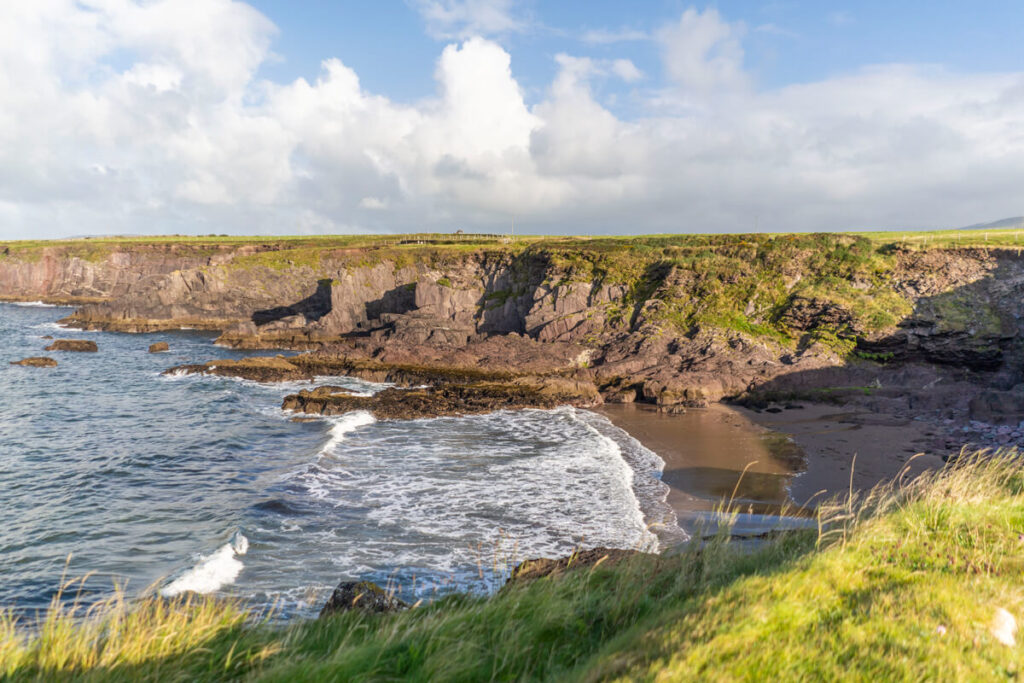
Wild Camping in Ireland
Officially, wild camping is prohibited in Ireland, but it is often tolerated as long as you treat nature respectfully and leave no trace. It is advisable to ask the landowner for permission beforehand if you plan to camp on private property. We only stayed at campsites and official car parks during our time there.
Fueling
Fuel stations are readily available in both urban and rural areas. However, in very remote areas, particularly in the west of Ireland, you should make sure you fill up in time, as petrol stations are less densely spaced there. Generally, however, we never had any problems finding a petrol station.
Most petrol stations have long opening hours, some are open 24 hours, especially along the motorways. However, in rural areas they may close earlier, especially on Sundays. We were always able to pay with our credit card (debit & credit) without any problems.
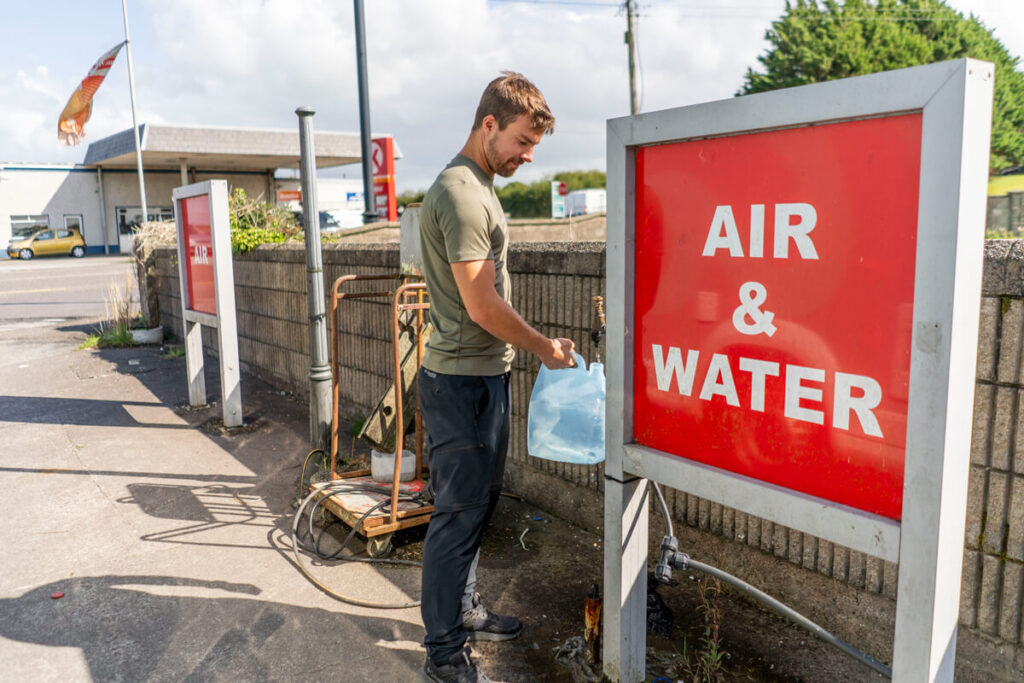
Fresh water, grey water, rubbish & Toilet
At some gas stations, especially larger or specialized motorhome service areas, you can also fill up with water, inflate tires, or dispose of wastewater and garbage. However, these services are not available everywhere, so plan your stops carefully.
At campsites, it is almost always possible to drain gray water, fill up with fresh water, and empty the toilet. You can also connect your motorhome to shore power there and charge the batteries. Some sites also have washing machines and smaller convenience stores.
We always carried our garbage in smaller garbage bags, as there are fewer large garbage bins in Ireland. We often saw large bins in supermarket parking lots. Otherwise, garbage bins were rather scarce. However, we were always able to dispose of a little trash at smaller trash cans at parking lots, gas stations, etc.
In the Park4Night app, you can find numerous such stations, parking lots, campsites, and much more in Ireland. With the paid version, you can even filter specifically for drinking water, toilet disposal, wastewater disposal, garbage disposal, or even electricity and showers.
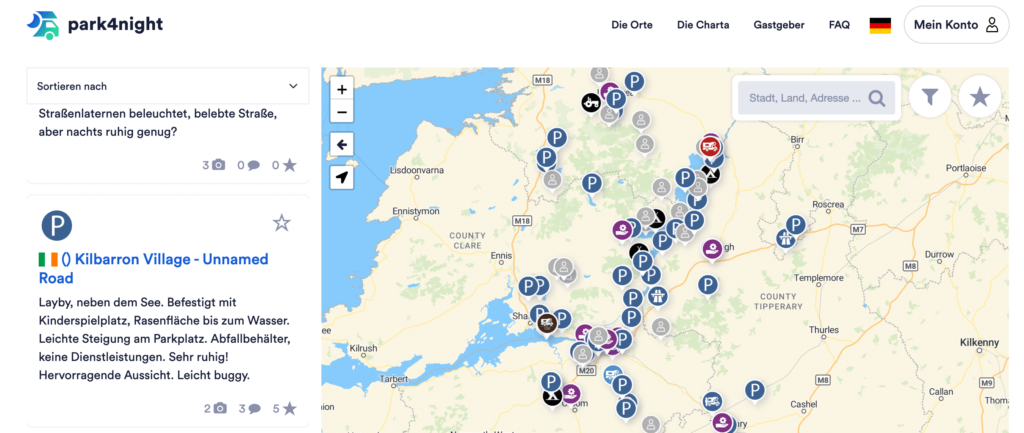
Shopping on the go
In Ireland, it’s no problem finding a mini-market or larger supermarket. Aldi and Lidl, as well as Tesco, Spar, SuperValue, and Dunnes Store (the latter comparable to Rewe or Edeka) are common. This meant we could always keep our fridge stocked and didn’t have to go without anything.
Most products are more expensive than in Germany. We definitely recommend bringing cosmetics from home. In Irish supermarkets, you can easily pay €5 to €7 for a bottle of shampoo. You should also bring sunscreen.
Costs of our round trip through Ireland
Below, we have listed our costs for Ireland. We had the motorhome for a total of 9 nights. We didn’t skimp and chose the best insurance package (approximately €240 extra). The costs for such a round trip are, of course, individual and are only intended as an example. In the end, we spent €1,170 per person (excluding flights).
Packing list for a motorhome trip
The packing list for a campervan trip is similar to the packing list for a houseboat trip. We have listed the most important things that you should definitely not forget.
- Waterproof and windproof clothing (rain jacket, water-repellent trousers)
- Sturdy shoes for hiking (Bolles hiking boots* | Marcos hiking boots*)
- Warm clothing (it can get cold on board)
- Slippers/clogs/flip flops for in between and the toilet/shower
- Swimsuit & towel (preferably quick-drying)
- Headgear (cap & hat) and sunglasses
- Sunscreen & Mosquito spray (better buy cheaply in Germany)
- Games for bad weather days (e.g. Cabo*, The Mind*, Wizzard*, Scout*)
- Power adapter for Ireland*
- Power bank* for charging cell phones in between
- Flashlight* for evenings/nights
- Fairy lights (often make the atmosphere much more cozy)
- Binoculars (always good, especially for wildlife observation and the night sky)
- Travel guides for Ireland (e.g. Michael Müller Verlag* or DuMont*)
Ireland by campervan – Our conclusion
We found our Ireland round trip really nice and thoroughly enjoyed exploring Ireland by campervan. It was a lot of fun traveling in our own little apartment. Some roads were quite narrow and cramped, but we always made good progress or were able to avoid them in time. While we couldn’t even drive on some roads with the motorhome, that didn’t bother us.
Ireland has so much to offer; you shouldn’t overpack your days. We quickly realized that we wouldn’t have enough time to drive further north (Donegal). The distances may not seem far at times, but it often takes longer, as you can only drive 60 km/h on the narrow roads in a motorhome.
What we underestimated was the weather. At the end of August, we only had two really nice sunny days. We read that August and September are generally a bit wetter. However, since we had to go to the island at the beginning of September for work anyway, we weren’t flexible with our schedule. Next time, we’d rather aim for May as our travel month.
And a final word about our motorhome: We really loved it and have almost nothing to complain about. On our next trip, we’d probably check out the roadsurfer website again and possibly even book the same model. If the motorhome were 1 meter shorter, it would be perfect. But even with a length of 7 meters, we managed very well on the island.